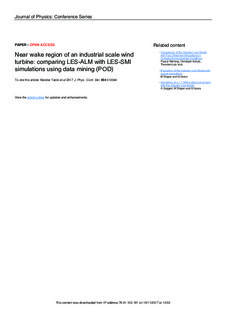| dc.contributor.author | Tabib, Mandar | |
| dc.contributor.author | Rasheed, Adil | |
| dc.contributor.author | Fonn, Eivind | |
| dc.contributor.author | Siddiqui, Muhammad Salman | |
| dc.contributor.author | Kvamsdal, Trond | |
| dc.date.accessioned | 2017-11-17T06:29:29Z | |
| dc.date.available | 2017-11-17T06:29:29Z | |
| dc.date.created | 2017-06-19T15:18:15Z | |
| dc.date.issued | 2017 | |
| dc.identifier.citation | Journal of Physics, Conference Series, 2017, 854, pp 10 | nb_NO |
| dc.identifier.issn | 1742-6588 | |
| dc.identifier.uri | http://hdl.handle.net/11250/2466752 | |
| dc.description.abstract | Accurate prediction of power generation capability needs proper assessment of blade loading and wake behavior. In this regard, the Sliding Mesh Interface (SMI) approach and the Actuator Line Model (ALM) are two diverse computational fluid dynamics (CFD) based approaches of simulating the turbine behavior, each having its own merits and demerits. The SMI technique simulates the unsteady flow by explicitly modeling the blades and their rotation using a dynamic mesh, while in Actuator Line Model, the blades are not modeled explicitly but each blade is resolved as a rotating line (made of N actuator segments), over which the forces are computed. The current work focuses on simulating an industrial scale reference turbine and in differentiating the near wake dynamics predicted by these two approaches using Large Eddy Simulation (LES) and Proper Orthogonal Decomposition (POD) technique (a data mining tool). Initially, the ALM is compared with FAST model for the prediction of variation of power coefficient with the Tip Speed Ratio (TSR). The ALM is able to capture the varying trend and it predicts a similar optimum tip speed ratio as the FAST model. At this optimum TSR condition, the ALM is compared with the SMI method for a study limited to the near wake region. Comparisons between SMI and ALM shows that : (a) The SMI is predicting more complex 3D nature of the flow, and (b) the POD shows that ALM captures the shear regions of wake but it does not capture the vast compendium of length and time scales of eddies as SMI does. However, despite these limitations, the ALM has been able to capture the qualitative trend in wake deficit and the power coefficient variation with tip speed. | nb_NO |
| dc.language.iso | eng | nb_NO |
| dc.rights | Navngivelse 4.0 Internasjonal | * |
| dc.rights.uri | http://creativecommons.org/licenses/by/4.0/deed.no | * |
| dc.title | Near wake region of an industrial scale wind turbine: comparing LES-ALM with LES-SMI simulations using data mining | nb_NO |
| dc.type | Journal article | nb_NO |
| dc.description.version | publishedVersion | nb_NO |
| dc.source.pagenumber | 10 | nb_NO |
| dc.source.volume | 854 | nb_NO |
| dc.source.journal | Journal of Physics, Conference Series | nb_NO |
| dc.identifier.doi | 10.1088/1742-6596/854/1/012044 | |
| dc.identifier.cristin | 1477265 | |
| dc.relation.project | Norges forskningsråd: 216465 | nb_NO |
| cristin.unitcode | 7401,90,11,0 | |
| cristin.unitname | Anvendt matematikk | |
| cristin.ispublished | true | |
| cristin.fulltext | original | |
| cristin.qualitycode | 1 | |

